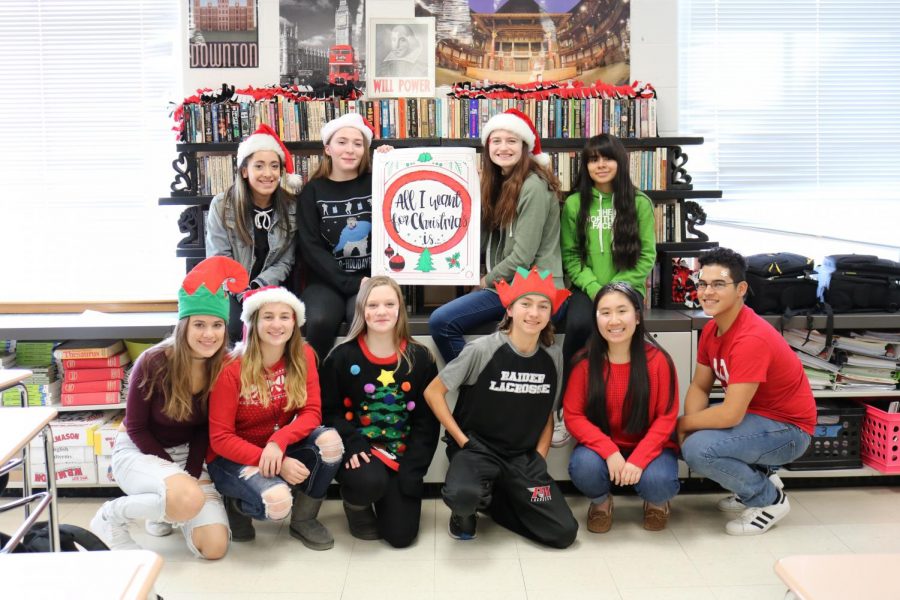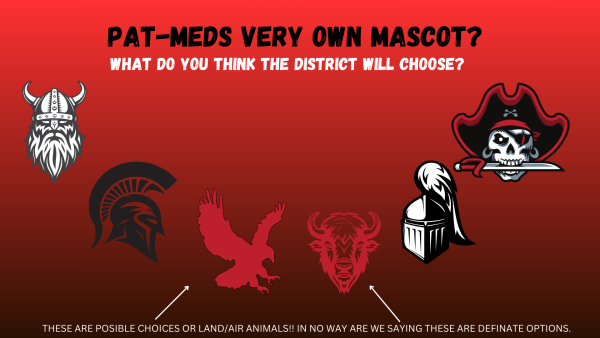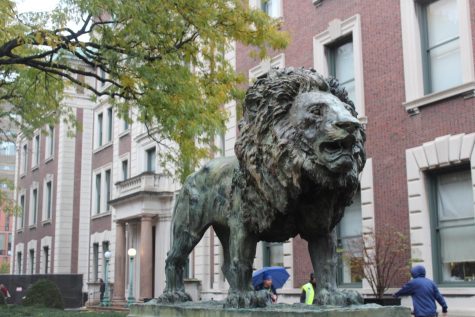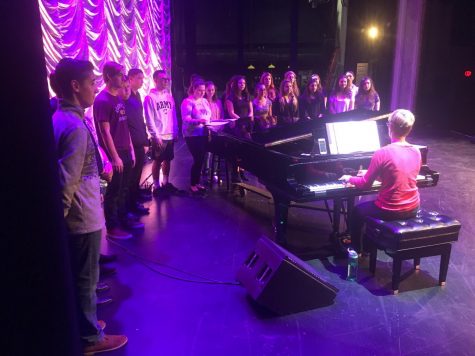Yes, Virginia, There is Still Holiday Spirit
A ‘Dear Santa’ history lesson meets nostalgic Christmas wishes. BEST OF SNO 2017
Photo by Alison Mckeough
Mrs. Mckeough’s AP Language students wrote letters to Santa (using persuasive language to convince him to get them what they want for Christmas) and sent them in to Macy’s “Believe” campaign, which donates $ to Make a Wish for every letter to Santa it receives.
With college application deadlines approaching and midterm exams coming around the corner, it’s hard to fathom that the holiday season is already among us. For seniors, it’s a challenge to choose between the $50-$85 dollar application fees and those perfect gifts for your friends and family. It feels as if the holiday season gets duller as we get older even if the houses on our street are getting brighter. (After seeing some of the blinding and luminous lawns on local streets, it’s easy to say that the plot of Deck The Halls wasn’t a stretch; it’s the real deal.) After all, the holiday season barely feels like a break anymore. As nice as it is to see family, it feels like we’ve just seen them all yesterday at Thanksgiving. (And no, insert-any-family-member’s-name-here, I haven’t found myself a boyfriend since the last time I saw you at Thanksgiving.)
The holiday season only gets scarier when parents and grandparents are asking you for a Christmas wish list. Immediately, your mind is set into a frenzy. What do I want for Christmas? Do I even want anything for Christmas? Many students are fast to quip, ‘My tuition paid in full, please.’ It seems that as we get older, there are less things that we want. Or maybe there’s only so many times we can request a new iPhone for Christmas and feel satisfied with our new tech.
It seemed easier to construct a wishlist when we were younger. We’d pay meticulous attention to Toys R Us flyers and various store advertisement commercials on the television. In only a matter of minutes, our lists were separated into things we ‘needed,’ things we wanted, and things that we would like to have if the other two categories were too expensive or just didn’t work out. Many lists were color coded as well. Maybe the Christmas season generated a lot more excitement when we were all writing to the big guy up in the North Pole.
Where did writing letters to Santa come from? The first letters regarding Mr.Claus was actually a letter from Santa himself. St. Nicholas would often warn kids of their behavior and advise them to be mindful of improving said behavior. One of St. Nicholas’ early purposes in history was to promote good manners to children. Parents who took up the role of Santa Claus would leave letters for their children by the fireplace and kids often wrote their replies and left them there as well.
It wasn’t until the late nineteenth century that the idea of writing letters to Santa became normalized. Thousands of letters were received by the United States Post Office Department (now known as the United States Postal Service), but office workers deemed the letters as impossible to deliver, so they were often returned to the parents and children who had sent them. By the end of the century, the Post Office Department received lots of backlash from organizations, charities, and newspaper companies. This immediately changed the Postmaster General’s opinion on these letters, and starting in 1911, all letters that were addressed to Santa Claus were able to be delivered to “responsible institutions or individuals [for] philanthropic purposes.” In effect, writing letters to Santa became a distinguished American tradition. Instead of shouting up the chimney like Scottish children or leaving shoes out for the ‘Yule Lads’ – the 13 Father Christmases – like Icelandic children, Americans could be seen dropping their ‘Dear Santa’ letters into the nearest mailbox.
Various newspapers found themselves encouraging children to send letters to Santa and some went as far as publishing those letters in their circulations. In fact, it was Times who had been one of the main influences for the Postmaster General’s decision in 1911. However, one of most influential Christmas publications in newspaper history was the editorial from the New York edition of The Sun called Is There a Santa Claus? which included the phrase “Yes, Virginia, there is a Santa Claus.”
Virginia O’Hanlon, an eight year old girl from the Upper West Side of Manhattan, found herself writing to The Sun after asking her father if Santa Claus really existed. She began doubting the existence of Santa Claus after hearing her friends say that there was no Santa Claus. Francis Pharcellus Church, the author of the editorial at the time, had been known as an atheist and very cynical, so when he responded to O’Hanlon’s inquiry with phrases like “[h]e exists as certainly as love and generosity and devotion exist” and “[t]here would be no childlike faith then, no poetry, no romance to make tolerable this existence,” it was completely out of character.
Since then, Is There a Santa Claus? has been a phenomenon and has been the most reprinted English editorial to date. Many department stores like Macy’s and Lord & Taylor have depicted the story in various window displays through the recent years. Additionally, in 2009, CBS aired a Christmas television special, Yes, Virginia, starring Bea Miller as Virginia and Neil Patrick Harris as her father. Macy’s has supported the story for years and even use the symbolic character of Virginia as one of the faces of their Believe campaign.
This year marks the 10th year of Macy’s Believe campaign and seasonal partnership with Make-A-Wish foundation. Through the Believe campaign, “Believers” of all ages are encouraged to send a letter to Santa at various red letterboxes at any Macy’s store or online. For every letter received, Macy’s will donate $1 to Make-A-Wish to grant wishes of children with critical illnesses. Over the years, Macy’s has donated a total of more than $15 million to Make-A-Wish. Not only does this bring holiday cheer to those who have written these letters to Santa, but the Believe campaign brings a whole year of excitement to critically ill children whose wishes will be granted.
In the past few weeks at Patchogue-Medford High School, Mrs. McKeough’s AP English Language & Composition classes have written and sent their own letters to Santa Claus through Macy’s Believe campaign. AP Lang students were given the chance to take a break from their rigorous class schedules and take part in something that’s both exciting and heart-warming. While writing a letter to Santa at this age can seem a little silly to most, Mrs. McKeough’s classes had fun with it and put their reluctances aside in order to support a magnificent cause. It’s wonderful to know that Patchogue-Medford students and teachers make the effort to bring joy to kids who are struggling.
In addition to the letters written to Santa, Mrs. McKeough and her AP Lang classes, with a few additions from Mrs. Sullivan’s English classes, reminisced over gifts that they had asked Santa for when they were younger. It’s incredible to see how our interests and wants develop over time. While kids today are quick to request the new iPhone for Christmas, AP Lang students found themselves remembering how much they wanted the Barbie Girl Dreamhouse, Kids Jeep, newest XBox, and Hot Wheels. Other wishes included: American Girl dolls, Heelies, Younger Siblings, Webkinz, Club Penguin Memberships (R.I.P. Club Penguin), iPods, a Wii, Polly Pocket dolls, Nerf Guns, Build-a-Bear, Legos, and no socks! Looking back at it now, it’s safe to say that we can remember at least one of these popular items being included in our wish lists to Santa Claus as a child.
In a time where it can be hard to find positivity and light in life, the holiday season continues to serve as a wonderful time to remind others to bring light to places where they cannot find it. Take time to tell your friends and family how much you value your relationship with them, donate toys or money to your favorite charity, or make a holiday card to a soldier or hospitalized children. Write a letter to Santa and send it through Macy’s Believe campaign.

Adelphi Quill Award Winner - 3rd Place, Most Outstanding Reporter (2018)
Grade 12
"You can never be overdressed or overeducated." - Oscar Wilde






